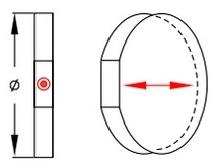Multiple order waveplate means the retardance of a light path will undergo a certain number of full wavelength shifts in addition to the fractional design retardance. The thickness of multi order waveplate is always around 0.5mm. Compared with zero order waveplate, multi order waveplate is more sensitive to wavelength and temperature changes. However, they are less expensive and widely used in many applications where the increased sensitivities are not critical.
|
Features: Thickness: 0.2-0.5 mm High Damage Threshold Better Temperature Bandwidth Low Cost |
 |
Item No :
WPLProduct Origin :
FuZhouSpecifications:
|
Material:
|
Quartz
|
|
Diameter Tolerance:
|
+0.0, -0.1mm
|
|
Wavefront Distortion:
|
λ/8 @ 632.8nm
|
|
Retardation Tolerance:
|
λ/300
|
|
Parallelism:
|
<1 arc second
|
|
Surface Quality:
|
20/10
|
|
Clear Aperture:
|
>90%
|
|
Coating:
|
S1&S2: R<0.2% @ wavelength
|
|
Standard wavelength:
|
266nm, 355nm, 532nm, 632.8nm, 780nm, 808nm, 850nm, 980nm, 1064nm, 1310nm, 1480nm, 1550nm
|
Standard Products:
|
Half Waveplates P/N#
|
Quarter Waveplates P/N#
|
Diameter(mm)
|
|
WPL210
|
WPL410
|
10.0
|
|
WPL212
|
WPL412
|
12.7
|
|
WPL215
|
WPL415
|
15.0
|
|
WPL220
|
WPL420
|
20.0
|
|
WPL225
|
WPL425
|
25.4
|
|
WPL230
|
WPL430
|
30.0
|
Technical Advantages of Multi-order Waveplates:
Multi-order waveplates achieve high-magnitude phase retardation by increasing the optical thickness of birefringent materials, offering key advantages such as high retardation precision with phase errors <±1% at the design wavelength, enabling precise polarization control for fixed-wavelength lasers. Their compact structure eliminates the need for complex cascading designs, making them highly suitable for integrated optical systems, while a high laser damage threshold (>10 J/cm² @ 1064 nm) ensures reliability in high-power applications. In spectral polarization measurement systems, their stable phase retardation keeps polarization degree measurement errors within 2%, facilitating high-precision polarization analysis in scenarios like atmospheric composition spectroscopy and other advanced optical characterization tasks.
